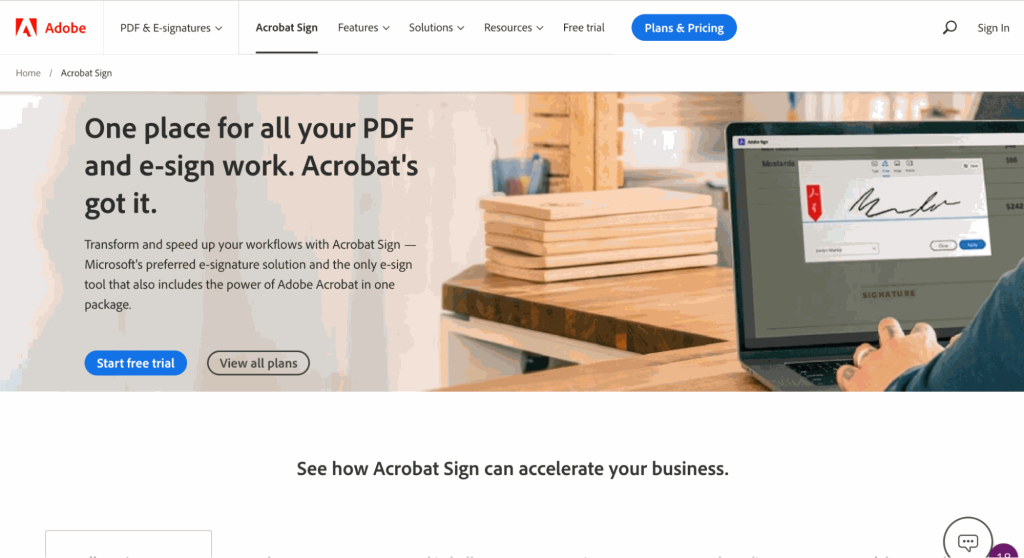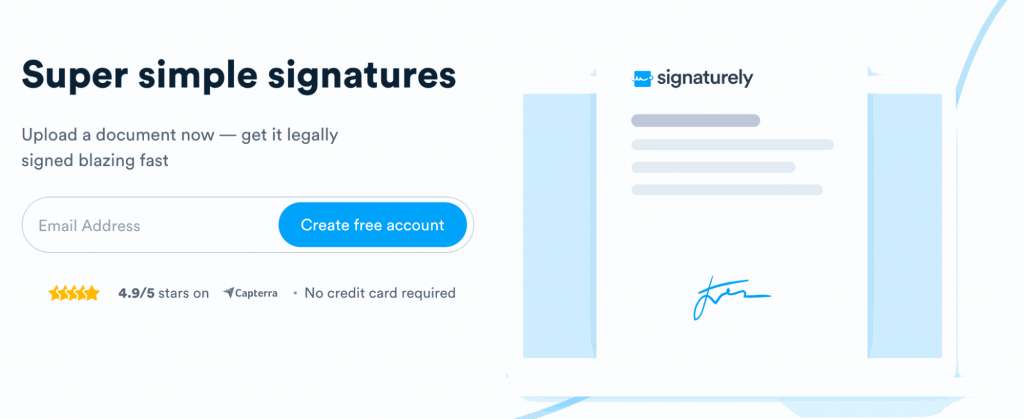Adobe Sign and HelloSign are two of the most popular digital signature solutions on the market today. Both tools allow you to sign documents online electronically. Using one of these applications can save your company time, effort, and money. However, which software is the superior option for your needs? This article will compare Adobe Sign vs. HelloSign, looking at the following criteria:
- Key features
- Integrations and API
- Ease of use
- Security
- Use cases
- Plans and pricing
The comparison will provide you with insight into which provider is best suited for your business. We’ll also conclude by giving you our opinion on both electronic signature platforms.
Let’s get started.
Introducing Adobe Sign vs. HelloSign
Let’s briefly examine each tool before comparing the two.
Adobe Sign Overview

Adobe Sign is a document signing software that makes signing contracts, agreements, and forms online easy. The web-based solution offers numerous useful features, including bulk sending, custom branding, and more.
The key features are the eSignature creator and the signature request functionality. You can create your own digital signature, typed or drawn. You can add it to the uploaded documents and send them to your contract parties for signature collection.
Adobe Sign is suited to businesses that use existing Adobe products. It’s part of the Adobe Document Cloud, an online platform for managing PDF files. You can electronically sign contracts and agreements quickly with this tool.
HelloSign Overview

HelloSign is a cloud-based digital signature software application that allows you to digitally sign documents online. The platform allows you to create a digital signature, which can be typed or drawn. The signature can then be added to documents, making them legally binding.
You can also request signatures from other contract parties. You can dramatically scale up and streamline your document workflows combined with the bulk send feature. Reminders and notifications ensure a smooth contract lifecycle.
HelloSign is ideal for companies of all sizes and industries. However, it’s most suited to small businesses with less than 50 employees. It can help you streamline various business workflows, including sales contracts, NDAs, insurance documents, and financial agreements.
Adobe Sign vs. HelloSign: Comparison Guide
Adobe Sign and HelloSign are popular eSignature tools, but which is superior for your needs? We’ve compared the software below, looking at several key criteria. These include the following: key features, integrations, API, ease of use, security, use cases, plans, and pricing.
1. Key Features
A software application is only as capable as its functionality. We’ve listed the key features of Adobe Sign and HelloSign below for comparison.
Adobe Sign Features
Adobe Sign offers a robust suite of features to make online document signing easy. The core features include signing uploaded documents and collecting signatures from contract parties.
The Tracking and management feature speeds up the lifecycle of your contracts. Email reminders gently prompt your signatories to sign your documents digitally, and bulk sending enables you to scale up and streamline your document workflow. These are just some of the key features.
Since Adobe Sign is part of the Adobe Document Cloud, it can access unrivaled PDF file features. You can create, edit, and sign PDFs effortlessly. Adobe created the PDF, so it makes sense that HelloSign can’t compare with Adobe Sign for PDFs.
Here’s a complete list of Adobe Sign features:
- Collect signatures
- Sign agreements
- Scan and sign on mobile
- Track and manage agreements
- Add a business stamp
- Prepare forms
- Customize languages
- Keep records and audit trails
- Create and share reusable templates
- Collect e-signatures from websites
- Collect payments from Braintree
- Advanced forms
- Advanced language support
- Send in bulk
- Integrations
- Team features
- PDF features
HelloSign Features
HelloSign offers several key features that facilitate the electronic signing of contracts more easily. The sign request functionality allows you to collect signatures from your contract parties. Pre-made templates save time creating documents, speeding up your contract lifecycle process.
You can use bulk sending to send large volumes of signature requests simultaneously, streamlining your document workflows significantly. One of the most notable features is the audit trail. It tracks events such as document sending, document signing, and more.
HelloSign offers a more comprehensive audit trail than Adobe Sign. It also has more to offer regarding analytics and reporting features.
Here’s a list of HelloSign features:
- Sign requests
- Templates
- Mobile app
- Audit trail
- Reminders and notifications
- In-person signing
- Bulk send
- Reporting features
- Team features
- API
2. Integrations and API
How well a tool integrates with your technology stack is essential. We’ve compared the integrations and APIs of each digital signature software below.
Adobe Sign Integrations
Adobe Sign is a versatile tool that integrates with various types of software, including CRM, CLM/CPQ, HR, and ERP platforms. Some of these include the following applications:
- Salesforce
- Salesforce CPQ
- HubSpot
- Microsoft Dynamics 365
- Oracle NetSuite
- Oracle CPQ
- Zoho CRM
- Agiloft
- SAP
- ServiceNow
- Google Drive
- Dropbox
- OneDrive
Adobe Sign and HelloSign integrate with the same tools for the most part, and there isn’t much of a difference between them. However, Adobe Sign is part of the Adobe Document Cloud, and this online PDF platform leverages Adobe’s comprehensive suite of tools.
The Adobe Sign API is restricted to users with enterprise and developer-tier accounts, enabling seamless integration of the UI into your applications. Therefore, you can digitally sign contracts faster, maximizing operational efficiency.
HelloSign Integrations
HelloSign is a versatile software that integrates seamlessly with your favorite tools. It works with a wide array of CRM platforms, including the following:
- SharePoint
- Salesforce
- Salesforce CPQ
- Microsoft Dynamics 365
- Gmail
- Google Docs
- Google Drive
- Google Workspace
- Dropbox
- Evernote
- HubSpot
- OneDrive
- Microsoft Word
- Oracle CEC
- Oracle CPQ
Like Adobe Sign, HelloSign integrates with a wide variety of SaaS tools. There is little difference between the two software programs. The Dropbox Sign API syncs the eSignature solution with your website and applications. It’s similar to the Adobe Sign API.
3. Ease of Use
The most feature-rich tool is only helpful if it’s easy to use. You need software that makes electronically signing documents easy. We’ve compared the usability of Adobe Sign and HelloSign below.
Adobe Sign Ease of Use
Although a capable platform, Adobe Sign isn’t as user-friendly as other e-signature tools today. The dashboard is more complicated than HelloSign, which can cause confusion with navigation. It’ll take your team a little longer to master this platform.
Adobe Sign supports its customers with a dedicated help center that provides process documentation. There’s also a beginner’s guide, as well as tutorials that range from novice to expert. You can join a community forum and ask for help if you are stuck on a problem.
HelloSign Ease of Use
HelloSign has an intuitive interface that’s easy to use and can be mastered quickly. It’s lightweight and simple to navigate. You can upload a document from the dashboard, digitally sign it, and send it out for signature collection.
HelloSign offers many types of support to its customers. There is a support center that provides process documentation and learning courses. You can also submit a ticket for help if you can’t find a solution to your problem.
4. Security
Cybersecurity is crucial for cloud-based technologies like Adobe Sign and HelloSign. As such, we’ve detailed the security measures of each tool below.
Adobe Sign Security
Adobe Sign prioritizes the privacy and security of its platform, including your sensitive data, documents, and personal information. It uses hundreds of protocols and measures to meet industry standards and regulations.
Adobe Sign uses Amazon Web Services (AWS) and Microsoft Azure as its cloud-based service data centers. Only Adobe employees, data host employees, and authenticated contractors can access the secure sites.
Adobe Sign utilizes web servers equipped with built-in security features that protect against common cyberattacks. A firewall ensures you maintain firm access control from the protected network to the internet. Adobe Sign also uses AES 256-bit encryption to protect documents.
Adobe Sign complies with laws and regulations worldwide as a global digital signature solution. You can use the platform to create legally binding eSignatures that adhere to the ESIGN Act of 2000.
HelloSign Security
HelloSign considers the security and privacy of its customers’ data to be its top priority. It uses several methods to protect your sensitive information, and yearly, independent third-party auditors inspect these privacy-related controls. We’ll go over these below.
Data deletion ensures that HelloSign destroys your data when requested. Documents involving multiple parties are deleted when the legal hold process has been completed or when the other parties decide.
HelloSign is PCI-compliant, and all payments are made through Stripe. HelloSign doesn’t host payment information, such as cardholder data, on its servers. All documents are protected behind a firewall and encrypted using AES 256-bit encryption.
HelloSign uses Amazon Web Services (AWS) for its data center hosting. Other security features include an audit trail, permissions, and a dedicated security team.
All digital signatures made on the HelloSign platform are legally binding. HelloSign complies with the ESIGN Act of 2000 in the United States and several other international laws. HelloSign is used worldwide.
5. Use Cases
Do you want a better idea of how Adobe Sign and HelloSign can help your business? We’ve outlined some use cases and relevant case studies below.
Adobe Sign Use Cases
Adobe Sign is a capable tool that can add value to your technology stack and help companies of all sizes and industries. All organizations process documents, contracts, and agreements to operate. Adobe Sign can streamline this workflow, saving your business time, effort, and money.
Acepodia—a clinical-stage biotechnology company—wanted to go paperless and digitize its document process. Using paper documents and wet signatures was expensive and time-consuming. Many of Acepodia’s employees work remotely as well.
Switching to a digital document workflow would alleviate many of these concerns and collaborative challenges. As a biotech company, Acepodia required an electronic signature platform that was compliant with FDA regulations.
Adobe Sign was the obvious choice, allowing Acepodia to accelerate document turnaround while maintaining regulatory compliance. The company now processes documents in hours instead of weeks.
HelloSign Use Cases
HelloSign is ideal for businesses of all sizes and industries. All companies run on document processes; HelloSign can cut paper costs and speed up document turnaround. It’s a valuable technology to add to your existing stack.
There are plenty of case studies on the HelloSign website. The success stories span multiple industries. Jasper AI—an AI-powered content writing tool—used HelloSign to help raise $1.85 million in funds from 35 investors. It helped process contracts faster and more efficiently.
Breezy HR adopted HelloSign to streamline the process of getting offer letters signed, eliminating the need to redirect customers to a third-party website. Vote.org used the HelloSign API so absentee voters from several US states could apply for an absentee ballot.
These are just a few examples of HelloSign’s case studies, with many more available on its website.
6. Plans & Pricing
We’ve listed the pricing plan details of each eSignature tool below.
Adobe Sign Plans
Adobe Sign has five pricing plans; two are for individual users, and three are for teams. The individual plans have three payment schedule options: monthly with an annual commitment, annual, and monthly. Paying month-to-month without any commitment is more expensive.
The two individual plans are Acrobat Standard and Acrobat Pro. Here’s what you need to know about them:
- Acrobat Standard: $12.99 per month with an annual commitment, $155.88 per year, or $22.99 per month. You can sign documents, collect and track signatures, edit, share, and convert PDFs, and more.
- Acrobat Pro: $19.99 per month with an annual commitment, $239.88 per year, or $29.99 per month. You get all the features from the Acrobat Standard plan, plus bulk sending for signature requests, PDF conversion, custom branding for agreements, and more.
The three team plans include Acrobat Standard for teams, Acrobat Pro for teams, and Acrobat Sign Solutions. The team plans require an annual commitment, and you can pay monthly or in full for the year. Here’s what these plans cost and what’s included with each:
- Acrobat Standard for teams: $14.99 per user per month or $179.88 per user per year. You get all the features from the individual plan, plus desktop and mobile signing, Admin Console access, and more.
- Acrobat Pro for teams: $23.99 per user per month or $287.88 per user per year. You get all the features from the individual plan, eCommerce integrations, and a website eSignature collection.
- Acrobat Sign Solutions: This is a custom plan for larger enterprises. Contact the sales team for a quote. You get all the features from the individual plan, plus Salesforce, Workday, and ServiceNow integrations.
Acrobat Pro has a 7-day free trial, while Acrobat Sign Solutions has a 30-day free trial.
HelloSign Plans
HelloSign has four pricing plans: Free, Essentials, Standard, and Premium. You can pay yearly or monthly, and all plans offer a 30-day free trial. Here’s how much each plan costs and what you get:
- Free: You get one user, three signature requests per month, an audit trail, a mobile app, and more.
- Essentials: $198 per year or $22 per month. You get one user, unlimited signature requests, five templates, an audit trail, a mobile app, integrations, and more.
- Standard: $660 per year or $33 per user per month. You get one user and can buy more if needed. You get everything from the Essentials plan, plus fifteen templates, branding, bulk send, team features, and more.
- Premium: This plan is a custom offering for larger enterprises. You’ll need to contact the sales team to get a quote. It starts at a minimum of five users and includes all of HelloSign’s features.
Adobe Sign vs. HelloSign: Which Should You Choose?
We’ve compared both tools, but which comes out on top? Both are effective but suited to different uses. You’ll find our conclusions below.
Adobe Sign: Best For Signing PDF Files
Due to its superior PDF features, Adobe Sign is best for signing and processing PDF files. Consider using it if your business primarily uses PDF files for its documents, contracts, forms, and agreements.
Adobe Sign is part of the Adobe Document Cloud, an online service that combines the capabilities of Adobe Sign with other Adobe tools. Some of them include Adobe Scan and Adobe Acrobat Reader. Here are other alternatives to Adobe Sign if you’re interested.
HelloSign: Best For Small Businesses
HelloSign is the better option for smaller businesses, as it offers a free plan, whereas Adobe Sign doesn’t. It also offers an extended free trial, allowing you to test the software more comprehensively before making a purchase.
Compared to Adobe Sign, HelloSign is also easier to use. Its user interface is intuitive, making for easy navigation. Your team can learn how to use the platform very quickly. Adobe Sign is a little more complex and has a steeper learning curve.
Still Unsure? Choose Signaturely Instead

If you’re still uncertain about Adobe Sign and HelloSign, consider using Signaturely instead. It’s a cloud-based digital signature software that allows you to create, sign, manage, and process documents online.
Signaturely is a good HelloSign alternative for several reasons. It’s easy to use, offers superior customer support, and provides a more comprehensive business plan. It’s also better than Adobe Sign because its free plan makes it a viable free document signing solution.
Signaturely has many valuable features that can streamline your digital document workflow. You can create a legally binding digital signature, which can be typed or drawn. You can electronically sign documents and also collect signatures from your contract parties.
There are three Signaturely pricing plans: Free, Personal, and Business. Signaturely, unlike Adobe Sign, can be used as a free signature software.
The Free plan limits you to three signature requests per month. The Personal plan costs $20 per month and gives you unlimited signature requests and one template. The Business plan costs $30 per month and gives you unlimited signature quests and templates.
FAQs
HelloSign is better for businesses that only need to sign a few documents monthly. It offers a free plan that provides three signature requests per month, a mobile app, and an audit trail. DocuSign doesn’t have a free plan, but it’s better for larger businesses that need more features.
Adobe Sign electronic signatures are legally binding and protected in many countries worldwide.
What You Need to Remember About HelloSign vs. Adobe Sign
This article compares Adobe Sign and HelloSign, two popular electronic signature software applications. We looked at key features, integrations, API, ease of use, security, use cases, plans, and pricing.
Both platforms have their strengths and weaknesses. We found that Adobe Sign suits those who primarily use PDF files. On the other hand, HelloSign is ideal for smaller businesses and has a free plan, whereas Adobe Sign doesn’t.
